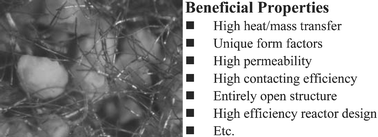A novel microfibrous composite bed reactor was developed and was demonstrated for high efficiency hydrogen production by the decomposition of ammonia at moderate temperatures in portable fuel cell power system applications. By using a high-speed and low-cost papermaking technology combined with a subsequent sintering process, sinter-locked three-dimensional microfibrous networks consisting of ∼3 vol% 8 µm (dia.) nickel microfibers were utilized to entrap ∼35 vol% 100–200 µm dia. porous Al2O3 support particulates. A CeO2 promoter and active Ni component were then dispersed onto the pore surface of the entrapped Al2O3 support particulates by a stepwise incipient wetness impregnation method. The microfibrous structure took advantage of a large void volume, entirely open structure, high heat/mass transfer, high permeability, good thermal stability, and unique form factors. Addition of ceria significantly promoted the low-temperature activity of Ni/Al2O3 catalyst particulates incorporated into the micorfibrous structure. The use of fine particles of catalyst significantly attenuated the intraparticle mass transport limitations. As a result, the present novel microfibrous composite bed reactor provided excellent activity and structure stability in ammonia decomposition, as well as low pressure drop and high efficiency reactor design. At a 90% conversion of a 145 sccm ammonia feed rate, the microfibrous entrapped Ni/CeO2–Al2O3 catalyst composite bed could provide a 4-fold reduction of catalytic bed volume and a 5-fold reduction of catalytic bed weight (or 9-fold reduction of catalyst dosage), while leading to a reduction of reaction temperature of 100 °C, compared to a packed bed with 2 mm dia. Ni/CeO2–Al2O3 catalyst pellets. This composite bed was capable of producing roughly 22 W of hydrogen power, with an ammonia conversion of 99% at 600 °C in a bed volume of 0.5 cm3 throughout a 100 h continuous test. These initial and promising results established that the microfibrous nickel-based catalyst composites were effective for high efficiency production of hydrogen by ammonia decomposition, while achieving a significant reduction of overall catalytic bed weight and volume. We anticipate our assay to be a new point for small-scale hydrogen production, where the microfibrous catalytic reactors considered in isolation can satisfy several of the most fundamental criteria needed for useful operation.

You have access to this article
 Please wait while we load your content...
Something went wrong. Try again?
Please wait while we load your content...
Something went wrong. Try again?


 Please wait while we load your content...
Please wait while we load your content...